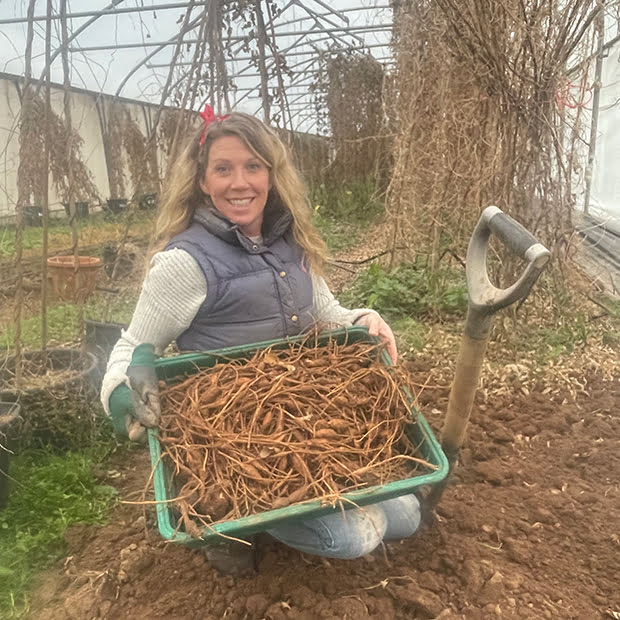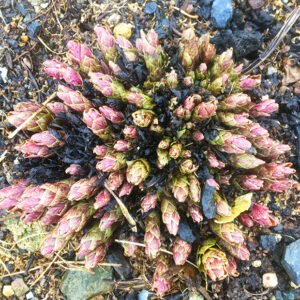Apios americana, Groundnut, Hopniss ‘Jewel’ – 1 tuber
£4.00
SUPPLIED AS 1 TUBER
A perennial climbing legume with high protein delicious tubers.
Awaiting Re-stock
We can email you when it's back ...
- Description
- About
- Caring for your tubers
- How to grow
- Harvesting
- Propagating more plants
- Life cycle
- Cooking and eating
Description
Apios americana also known as Groundnut or Hopniss is a herbaceous perennial climbing vine from the family Fabaceae. It produces delicious protein-rich edible tubers, attractive vines and scented pink flowers and has the added benefit of being able to fix nitrogen. It is our absolute favourite perennial vegetable to grow and we have had really nice results and decent tuber sizes with this one, so we are really happy to be able to offer tubers for sale. This is one of our most vigorous varieties with fast growing vines, flowers in summer and good yields of tubers.
About
Apios Americana, Groundnut also known as Hopniss from the Lenape word ‘Hobbenis’ is native to North America where it has long been a staple food for indigenous peoples. It has undergone some domestication and plant breeders have been working to improve it for many years. It has such great potential to become an important high protein food crop and is well worth experimenting with as part of your perennial vegetable garden or forest garden. In the wild, groundnut grows along the banks of rivers and lakes, usually found using trees and shrubs for climbing support. It forms long rhizomes under ground with ‘chains’ of edible tubers resembling a bead necklace. The tubers can be cooked and used just like potatoes but are more nutritious having more protein, calcium and iron. This plant has everything – fantastic tasting tubers, beautiful climbing vines and scented flowers and can fix nitrogen too.
Caring for your tubers
Apios americana tubers need to be kept in slightly damp compost during autumn and winter to stop them drying out until they are ready to sprout in spring. You can keep them in a small bag with some compost in the salad drawer of your fridge, or pot them up and keep them in an unheated greenhouse or polytunnel or cold frame. Check on them regularly to make sure tubers are firm. In spring they are ready to be sprouted and light and warmth will encourage them to sprout and produce their first vines.
How to grow
Apios americana needs moist but well drained soil in an open sunny positionand plants need climbing support. The taller and more vigorous the vines, the better the yield of tubers. Ideally you want to grow it on a 2 year cycle. There are several methods: For highest yields a dedicated raised bed with sturdy climbing support is best, where the rhizomes have room to branch out horizontally. They grow very shallowly and can be harvested by yanking out the chains of tubers. Alternatively they can be grown as part of a polyculture in a forest garden system and use surrounding plants for support. Growing them in large 40-50 litre containers is also possible, although the yields are lower, the harvesting is much easier as the containers can be tipped out to harvest the tubers.
Harvesting
Harvest tubers once vines have died back in autumn. If planted in spring wait until autumn of the following year to obtain your first harvest. You could leave some plants to grow on for a further year.
Propagating more plants
Save some of your best tubers for re-planting. This variety produces decent sized tubers with vigorous vines and prolific flowers.
Life cycle
Apios americana shows its first shoots in spring, produces climbing vines over the summer usually about 3m tall followed by dusky pink/maroon flowers in late summer. Vines die back in autumn and tubers remain dormant until the following spring, when the whole process begins again.
Cooking and eating
Use as a potato either boiled or baked or can be sliced and pan fried in olive oil with sea salt and oregano which is absolutely delicious. As this is essentially a wild edible, we advise that you start with a small portion as some people can have a digestive sensitivity to the tubers.













